
The first USS Amphion was a former German passenger liner SS Köln for Norddeutscher Lloyd from 1899–1917. Köln had been interned in Boston on the outbreak of war in Europe and confiscated in April 1917 when the United States entered the war. The ship was under the control of the United States Shipping Board (USSB) that allocated commercial type ships to military or civilian use during the war. Köln was renamed Amphion and operated by USSB for the Army as United States Army Chartered Transport (U.S.A.C.T.) Amphion as an animal transport taking mules, horses and general cargo to forces in Europe. At the end of the war the USSB allocated the ship to the Navy, which used the ship from April to September 1919 as a troop transport for returning the United States Expeditionary Force from Europe.

USS Comfort (AH-3) was a hospital ship for the United States Navy in World War I. She was the sister ship of USS Mercy (AH-4) but the two ships were not of a ship class. Comfort was known as SS Havana in passenger service for the Ward Line, and as USAT Havana in United States Army service before her Navy service. Her name was restored to Havana in 1927, and she was renamed SS Yucatán in 1935, and SS Agwileon in 1941. In World War II, she was known as USAT Agwileon and USAHS Shamrock in service for the United States Army.
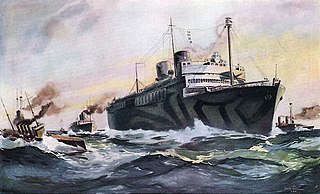
USS Siboney (ID-2999) was a ship transport for the United States Navy during World War I. She was the sister ship of USS Orizaba (ID-1536) but neither was part of a ship class. Launched as SS Oriente, she was soon renamed after Siboney, Cuba, a landing site of United States forces during the Spanish–American War. After her navy service ended, she was SS Siboney for the New York & Cuba Mail Steamship Co.. The ship was operated under charter by American Export Lines beginning in late 1940. During World War II she served the U.S. Army as transport USAT Siboney and as hospital ship USAHS Charles A. Stafford.
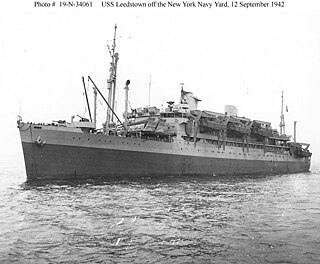
USS Leedstown (AP-73), built as the Grace Line passenger and cargo ocean liner SS Santa Lucia, served as a United States Navy amphibious assault ship in World War II. The ship had first been turned over to the War Shipping Administration (WSA) and operated by Grace Line as the WSA agent from February to August 1942 in the Pacific. In August the ship, at New York, was turned over to the Navy under sub-bareboat charter from WSA. She was sunk 9 November 1942 off the Algerian coast by a German submarine after German bombers caused damage the day before.
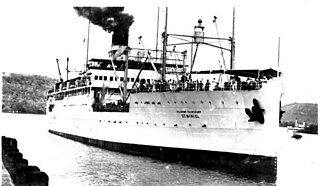
St. Mihiel was a troopship built for the United States Shipping Board by the American International Shipbuilding Corporation at Hog Island, Pennsylvania. The ship was operated from 1922 until mid-1940 as USAT St. Mihiel by the Army Transport Service. In July 1941 the ship was transferred to the Navy which commissioned her USS St. Mihiel with the hull number AP-32. In November 1943, she was transferred back to the Army and converted into the hospital ship, USAHS St. Mihiel.

USAT Thomas H. Barry, formerly SS Oriente, was a Ward Line ocean liner that became a United States Army troopship in the Second World War. She was intended for transfer to the United States Navy and assigned the hull number AP-45, but was not transferred and remained with the Army.
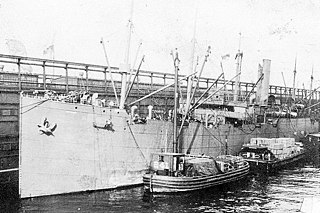
Empire Bittern was a steamship, built as a livestock-carrying cargo ship in 1902 at Belfast, Ireland as Iowa for the White Diamond Steamship Company Ltd of Liverpool. The ship was sold to the Hamburg Amerika Linie and renamed Bohemia in 1913.

USS Majaba (AG-43/IX-102) was the Design 1049 cargo ship Meriden built in 1919 by the Albina Engine & Machine Works, Portland, Oregon. All the ships were requisitioned by the United States Shipping Board (USSB) for World War I service. The ship was bought by the E. K. Wood Lumber Co., of San Francisco, California in 1923 and renamed El Capitan. The ship was chartered by the U.S. Navy through the War Shipping Administration (WSA) in April 1942 and commissioned as Majaba.

USS Tuluran (AG-46) was under construction for the British at the Toledo Shipbuilding Company as the cargo ship War Bayonet in 1917 when requisitioned by the United States Shipping Board (USSB) for World War I service. The ship was launched and completed as Lake Superior. The Navy acquired the ship from the USSB with assignment to the Naval Overseas Transport Service (NOTS) with the identification number ID-2995. The ship was returned to the USSB which sold the vessel in 1926. The ship was renamed C. D. Johnston III and that vessel operated out of Oregon until again sold and based in San Francisco. Another sale resulted in the vessel being renamed Anna Shafer which was acquired by the War Shipping Administration (WSA) in 1942 and allocated to the Navy for World War II service.

W. L. Steed was a steam tanker built in 1917–1918 by Bethlehem Shipbuilding Corporation of Quincy for Pan American Petroleum and Transport Company, with intention of transporting oil and petroleum products between Mexican and Gulf ports and the Northeast of the United States. The ship was briefly requisitioned by the US Government during World War I but returned to commercial service in early 1919. The ship was named after William L. Steed, superintendent of the Mexican Petroleum Company of California.
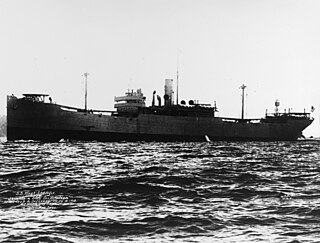
USS West Lianga (ID-2758) was a cargo ship for the United States Navy during World War I. She was later known as SS Helen Whittier and SS Kalani in civilian service under American registry, as SS Empire Cheetah under British registry, and as SS Hobbema under Dutch registry.
The Skinner & Eddy Corporation, commonly known as Skinner & Eddy, was a Seattle, Washington-based shipbuilding corporation that existed from 1916 to 1923. The yard is notable for completing more ships for the United States war effort during World War I than any other American shipyard, and also for breaking world production speed records for individual ship construction.

SS Santa Rosa was a passenger and cargo ocean liner built for the Grace Line for operation by its subsidiary Panama Mail Steamship Company of San Francisco. She was the first to be launched and operating of four sister ships, the others in order of launch being Santa Paula, Santa Lucia and Santa Elena. All four ships, dubbed "The Four Sisters" and "The Big Four" were noted as the finest serving the West Coast and were of advanced technology. All served in World War II as War Shipping Administration (WSA) troop ships. Both Santa Lucia and Santa Elena were lost in air and torpedo attacks off North Africa.

SS Santa Paula was a passenger and cargo ocean liner built for the Grace Line. She was the second of four sister ships ordered in 1930 from the Federal Shipbuilding and Drydock Company of Kearny, NJ. Her regular service route included inter-coastal service between the east coast and the west coast of the US via the Caribbean and the Panama Canal. She later sailed on cruises from New York to the Caribbean and South America. She was the second of three vessels to bear the name Santa Paula for Grace Line service.

USS Lake Tulare (ID-2652) was a cargo ship of the United States Navy that served during World War I and its immediate aftermath.

Corvus was a steam cargo ship built in 1919 by Columbia River Shipbuilding Company of Portland for the United States Shipping Board as part of the wartime shipbuilding program of the Emergency Fleet Corporation (EFC) to restore the nation's Merchant Marine. The freighter was operated on international and domestic routes through 1944. Early in 1945 she was transferred to Soviet Union as part of lend-lease program and renamed Uzbekistan. After several months of operation, the freighter was rammed by another vessel on 31 May 1945 and was beached to avoid sinking. She was subsequently raised and towed to Portland where she was scrapped in 1946.
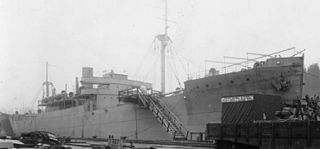
SS Jacona was an Emergency Fleet Corporation Design 1014 cargo ship launched in 1919 for the United States Shipping Board (USSB). In the glut of shipping after World War I, the ship was laid up until selected to be converted into the first specifically designed powership.

USS Santa Olivia (SP-3125) was a cargo ship and later troop transport that served with the United States Navy during and after World War I. The ship later went into merchant service as a freighter, and during World War II took part in a number of transatlantic convoys.

USS Radnor (ID-3023) was a cargo ship and later troop transport that served with the United States Navy in 1918–19, during and shortly after World War I. The ship later went into merchant service, and in 1948 under Chinese ownership reportedly became the first all-Chinese ship to visit South America. Radnor was originally ordered as SS War Indian by a private company, but with U.S. entry into World War I in April 1917, she was requisitioned by the U.S. Navy for use as a cargo ship. Commissioned as USS Radnor (ID-3023) in May 1918, the ship spent the remainder of the war transporting cargoes for the Navy. After the war, USS Radnor was converted into a troop transport and used to repatriate U.S. troops home from France.

The SS Harry Luckenbach, built as a cargo ship ordered by the Luckenbach Steamship Company and built at Sun Shipbuilding and Drydock Co. in Chester, Pennsylvania in 1919. The as yet unnamed ship was requisitioned by the United States Shipping Board (USSB) before completion and converted to a troop transport. The USSB allocated the ship, which had been fitted out with temporary troop accommodation in its cargo spaces, to the Navy which commissioned the ship on 7 July 1919 as USS Sol Navis with the Identification number 4031A. The ship was decommissioned October 1919 after two trips to France.



















